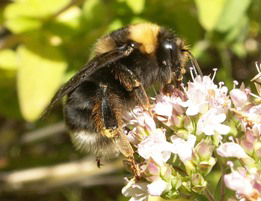Bumblebees have smelly feet. After feeding on a flower, they leave a chemical scent to warn other bumblebees to avoid that flower because the nectar has already been taken.
Photo Credit: Derrick Ditchburn
Bombus spp.
Common Name: bumblebee
Other Common Names: bumble bee
Other Scientific Names: Alpinobombus spp., Bombias spp., Cullumanobombus spp., Psithyrus spp., Pyrobombus spp., Subterraneobombus spp., Thoracobombus spp.
Animal Guild: Insect
Class > Order > Family: Insecta > Hymenoptera > Apidae
What does the species look like?
Bumblebees are large, robust bees, typically with yellow-black coloration. They have two sets of transparent wings with black veins. The front set of wings is larger than the hind set. Females have pollen baskets on their hind legs. The body is covered with hair of various colors, often yellow and black; the body color below the hairs is black.
Similar species: Bumblebees can be confused with carpenter bees. Carpenter bees have a shiny, smooth, all-black abdomen, whereas bumblebees have a fuzzy abdomen that typically has yellow or white coloration, in addition to any black that may be present. Carpenter bees bore into wood, but bumblebees do not.
For an online key to the eastern bumblebees, visit http://pick4.pick.uga.edu/mp/20q?guide=Bombus.
Where is the species found?
States & Provinces
AB, AK, AL, AR, AZ, BC, CA, CO, CT, DC, DE, FL, GA, IA, ID, IL, IN, KS, KY, LA, MA, MB, MD, ME, MI, MN, MO, MS, MT, NB, NC, ND, NE, NH, NJ, NL, NM, NS, NT, NU, NV, NY, OH, OK, ON, OR, PA, PE, QC, RI, SC, SD, SK, TN, TX, UT, VA, VT, WA, WI, WV, WY, YT
Distribution
Bumblebees occur primarily in the Northern Hemisphere but are native to every continent except Antarctica and Australia (although bumblebees have been introduced to New Zealand). In North America, the range extends from Alaska and extreme northern Canada (Ellesmere Island) south through most of the continent, including all of the United States, except Hawaii.
General Phenology and Life History
In northern latitudes, bumblebees usually overwinter as hibernating queens. Queens emerge in the spring and search for a nest site such as an abandoned mouse or bird nest or a bunch of dry grass. Once she finds a suitable nest site, the queen builds a waxy honey pot and fills it with honey. She also makes a ball of pollen (known as “bee bread”) in which she lays eggs. The queen broods the eggs, which hatch after a few days. The larvae are fed pollen and eventually pupate and emerge as adults. The colony grows in size during the summer, reaching dozens to hundreds of bees depending on the species. Fertilized eggs turn into females and unfertilized eggs, usually produced late in the season, become males. Depending on whether the queen emits a pheromone (scent), each fertilized egg will become either a worker or a queen. New queens leave the colony, mate, build up fat reserves by drinking lots of nectar, and hibernate in crevices or other protected areas. By the end of the season, the original colony dissolves as the remaining workers and queen die. Some species may go through two colony cycles per year. In tropical regions, bumblebees can be active year-round.
Which phenophases should I observe?
Do you see/hear...?
Activity
Adults More...
For abundance, enter the number of individual animals observed in this phenophase.
Male adults Bombus spp. , males are much smaller than females in some species.
For abundance, enter the number of individual animals observed in this phenophase.
Flower visitation For abundance, enter the number of individual animals observed in this phenophase.
Reproduction
Mating Bombus spp. , males are much smaller than females in some species, and mating can occur at rest (more typical) or in flight.
For abundance, enter the number of individual animals observed in this phenophase.
Nest building Bombus spp. , one or more females build a nest of wax cells that, depending on the species, may be constructed above ground in thick grass or a wood cavity, or underground in a hole or abandoned burrow.
For abundance, enter the number of individual animals observed in this phenophase.
Nest provisioning Bombus spp. , pollen is carried on the hind legs in bright yellow, orange, or white pollen baskets.
For abundance, enter the number of individual animals observed in this phenophase.
Development
Dead adults For abundance, enter the number of individual animals observed in this phenophase.
Method
Individuals in a trap For abundance, enter the number of individual animals observed in this phenophase.
What do these phenophases look like?
The following Phenophase Photo Guides for this species have been vetted for accuracy by the USA-NPN National Coordinating Office. Most photo guides are developed for a particular local or regional monitoring effort, and some of the content may not apply to your effort or your region. However, we make them available to provide as much help as they may in illustrating phenophases for this species. If you have high quality phenophase photos that you are willing to share with us, please visit the Phenophase Photo Guidelines page.
Be aware there is variation from individual to individual within a species, especially across different regions, so your plant may not look exactly like the one pictured.
Since they do not always include complete definitions for the species, use these photo guides ONLY in conjunction with the official Nature's Notebook phenophase defintions included in the table above, in the phenophase definition sheet that downloads with the datasheet, or in the Observe screen in the mobile app.
